Two relatively new spots (both opened, I think, within the last year) for traditional sushi… the biggest plus from my perspective is… no cream cheese!
[Side note: for those “in the know”, I’m going to start adding in the w3w location of restaurants when I review them. For those not in the know, it may, or may not, be worth finding out what that is, but if not, just ignore the three-word combos following addresses. Or, find them confusing and think I didn’t proofread. Either works for me.]
Chef’s Choice
Nare Sushi, Echeverría 1524, Belgrano [w3w: ages.shutting.gladiators] – nestled in among the various businesses on a side street just off of Chinatown, this place has been like a quiet wave approaching. Not quite a tsunami, because no one gets quite that excited about it, but a sort of ground swell of folk talking about it. I had no real idea what to expect, because the general level of commentary has just been, “you have to go, you have to do their omakase” (chef’s choice menu). So, on a recent bright sunny day, I popped over to Barrio Chino, shopped for a few things needed for the pantry, and presented myself when they opened up at 12.30 for lunch.
Two young Argentine guys standing behind a counter stacked with kitchen implements, ingredients, bills, and generally, just kind of “stuff”, greet me happily and direct me to take a seat at one of the two tables for two (and there’s a table for four, and there are four seats at the bar, but the bar is covered with “stuff”, as noted). In case your math skills are rusty, that’s 12 seats total. Over the next 10-15 minutes they gradually clear off the stuff and set the bar for eating as well, and shortly, one other person, apparently a regular, pops in and grabs a seat there, chatting amiably with them as they work.
The menu is short and sweet, it’s got basically, nigiri or sashimi, coming in a sort of “whatever fish we have that day” ethos – the way a good sushi bar should be. I look, and they have a decent selection of maybe 10 varieties of fish and a couple of shellfish. I’m already quivering with anticipation, because, let’s face it, a sushi bar here with more than salmon, one kind of white fish, shrimp, and octopus automatically moves the game to a new playing field. Not to leave you quivering with the same, but of course, I order the omakase. (1000 pesos)
I’m generally fine with little cubes of soft tofu in a miso soup. I’ve been known to dig into an agedashi tofu – deep-fried tofu with dipping sauce, but hey, I’ve been known to dig into a lot of deep-fried stuff that would otherwise be questionable. And I’ve enjoyed lightly jiggling freshly made tofu. But normally, it’s a pretty uninteresting ingredient. And three cubes of it, even prettily presented, with a little mixed vegetable salad, jalapeño, and smoked bonito broth doesn’t sound like it’s going to cut it as an opening act. But it does. Oh, it does. If tofu arrived that way, I’d eat it, and smile happily.
There’s a bit of a delay, as it’s clear they’re working on the omakase, and also I’ve told them I’m not in a hurry, and the guy at the counter is clearly on a lunch break, so they get him his few pieces of sushi in between. I’m expecting a typical sort of omakase for here – maybe a dozen pieces of varied somethings. And then this arrives. Let’s count the fishes… there are 15 pieces of sashimi… there are 10 nigiri… and there are 4 pieces of a maki… that’s… 29 pieces of sushi. And… and… and… the nigiri are all different. No repeats.
[Note: A revisit, at dinner time, and they offer two options, the individual omakase or a two-person one. Respectively, they’re 20 and 30 pieces of sushi, though the latter includes soup, seaweed salad, and the tofu dish above, which apparently wasn’t really part of the lunch deal, nor was getting 29 pieces, I think the sushi chef/owner was just kind of showing off on my first visit.]
And, with being right there in Chinatown, the fish is pristinely fresh, most of it is served simply, with some of the best sushi rice I’ve had here in town, a few have little touches of marinades or garnishes. It’s just plain delicious. In the same class with Mirtuaki and Club M. Easily moving into my top five sushi spots. The only negative is it means that when I go to Chinatown, I’m probably not going to be eating Chinese food anymore… then again, the best Chinese restaurants in town aren’t in Barrio Chino, so maybe it’s not a loss.
Oh, and… “you have to go, you have to do their omakase“.
Taken to the Cleaners?
Tintorería Yafuso, Araóz 501, Villa Crespo [w3w: nuance.variety.recoup] – While the building may officially be listed as Juan Ramirez de Velasco 399, it’s on the corner, and the entrance is on the Araóz side, which seems to give Uber fits about how to get there. I read about this place somewhere recently – I think an article about the new hotspots to eat Asian food at, or maybe even the new wave of sushi spots, like Nare above. I don’t recall, but it went on my list just a couple of weeks ago. The space, as I gather, is the Yafuso family’s old dry cleaner (tintorería) and when mom and pop closed up shop, their son took over the space, gutted it, and reopened it as a Japanese grill and sushi bar, with ten seats around the kitchen. It has a very Midnight Diner: Tokyo Stories feel to it (a TV series that if you love Japanese food and “stories”, you have to watch on Netflix).
The menu is handwritten (though photocopied from that), and includes a half dozen dishes from the grill or fryer, and a choice of sushi or sashimi platters, plus one “open roll” they call a tekkaba (a tekkaba is a gambling den, and in the food world, is noted for being the origin of tekkamaki, the sort of cone shaped hand-rolls of the sushi world, because they could be held with one hand while eating, and using the other hand to continue gambling… or something). I didn’t have one, but the guy next to me did, and I kind of wish I’d photographed it – it was weird – imagine a half a sheet of nori seaweed, with rice topped with a fillet of grilled trout and some seasonings, and it’s served sort of hanging from the two ends of the nori, pinched together and handed across to the customer that way with the admonition to pinch tightly or the whole thing will flop open and dump the rice and fish on the table. It didn’t look easy to eat, and the guy sort of rolled it up himself, but it was too loose to really do that right. Strange. But….
Everyone gets a little welcome dish of goma-ae, spinach with sesame and soy. Simple presentation and tasty, though could have used a little more… oomph.
I order the sushi moriawase. It doesn’t say on the menu, but the chef tells me it’s 10 pieces. The nigiri, 7 of them, are huge. They’re massive pieces of fish, like 1.5-2 times normal sized sushi pieces. Except the shrimp, which for some reason have been cut in half, so it’s only part of the shrimp body, and one of them even missing its tail. And one is a piece of grilled meat, and another a huge slab of egg omelette. And then the maki roll is 3 tiny little pieces with nothing but rice and cucumber in them, and the nori doesn’t quite wrap around them for some reason, so they pop open when you try to pick them up. This guy has a thing for open rolls. The fish is all fresh, it’s all tasty, but it’s lost that delicacy that comes with thinly sliced pieces that you can pop in your mouth easily and let them practically melt on your tongue. And the rice doesn’t quite hold together, I’m left with clumps of rice on the plate where it falls off as I pick them up, and it could use more vinegar in it. None of it’s bad, but it’s disappointing, and especially for 500 pesos, given what I had above at Nare, or the 12 piece creative nigiri plate of Mirutaki which only runs 400 pesos.
And, in somewhat the same way, the half order of the robata, the seafood grill, is a bit meh. It’s all tasty – there are perfectly tender calamari tentacles and strips of calamari body, and little baby octopuses, accompanied by some sort of shaved pickled vegetable, but it’s kind of wan. At the least, it needs some rice, or something – it’s just a pile of chopped up bits of tentacled beings on a plate. 250 pesos for a half order (400 for a full order, which didn’t look to be double the size). Add in a beer (300 pesos for a 600ml of Sapporo!) and a tip, and it cost the same as Nare and isn’t even on the same playing field.
Really nice people, great service, love the ambiance… I might go back and try some of the other cooked dishes. I think I’d pass on the sushi again, though that open porch swing of a maki is, at the least, intriguing. For the moment, cautiously recommended.
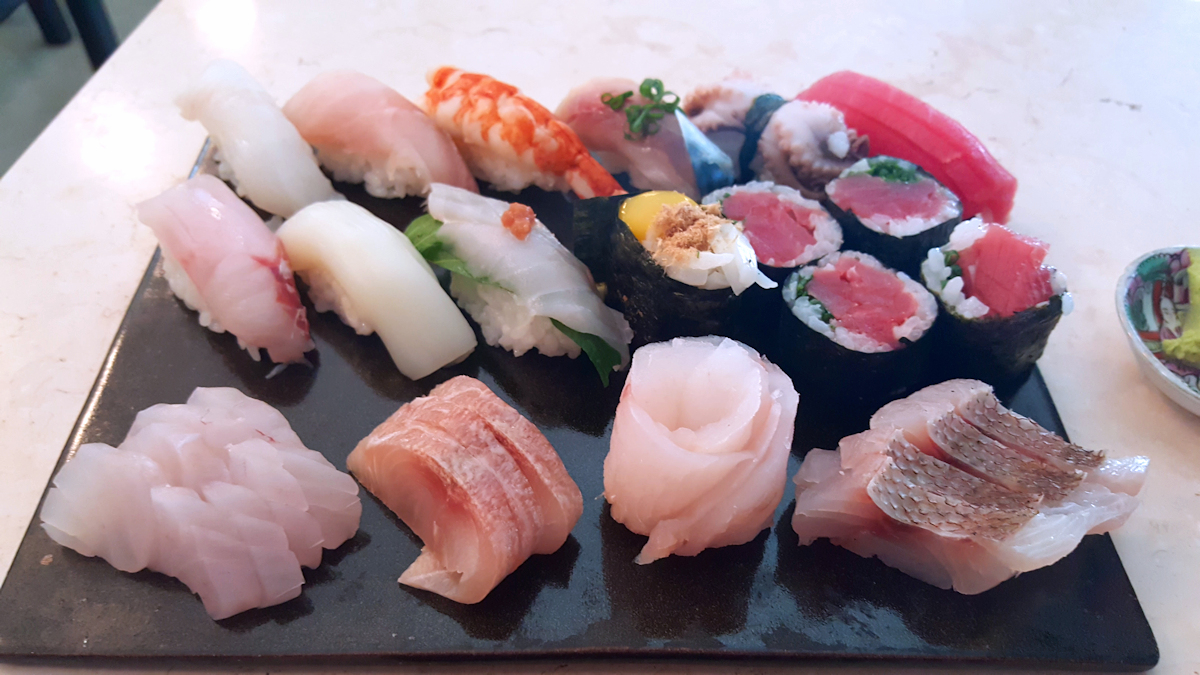
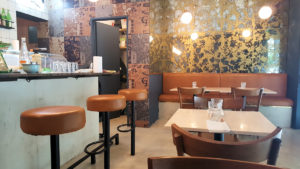
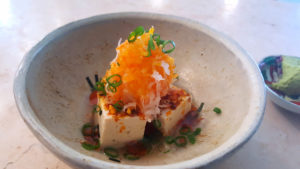
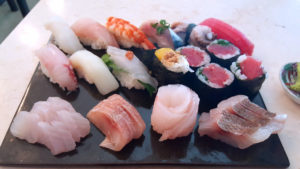
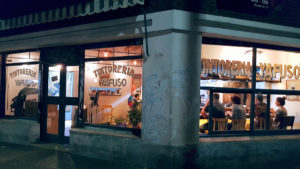
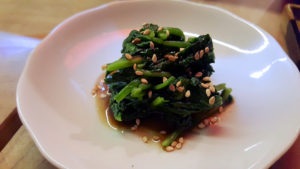
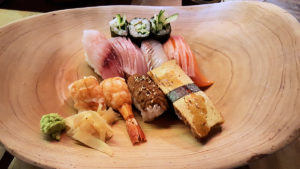
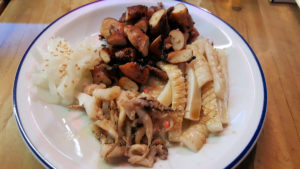
[…] are exceptions to all of the above, of course. There are places like Mirutaki and Nare that offer a selection of fish, usually around 6-7 different varieties, plus shellfish. And […]
[…] It’s also just half a block from the much acclaimed, and extraordinarily hard to get into, Tintoreria Yafuso, and I prefer this […]